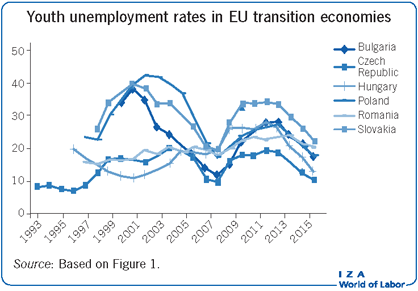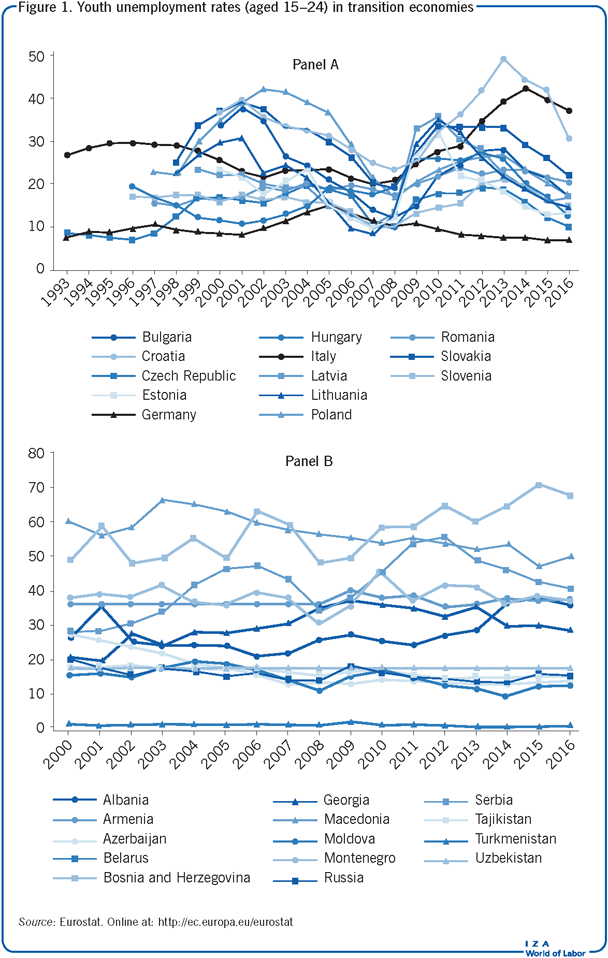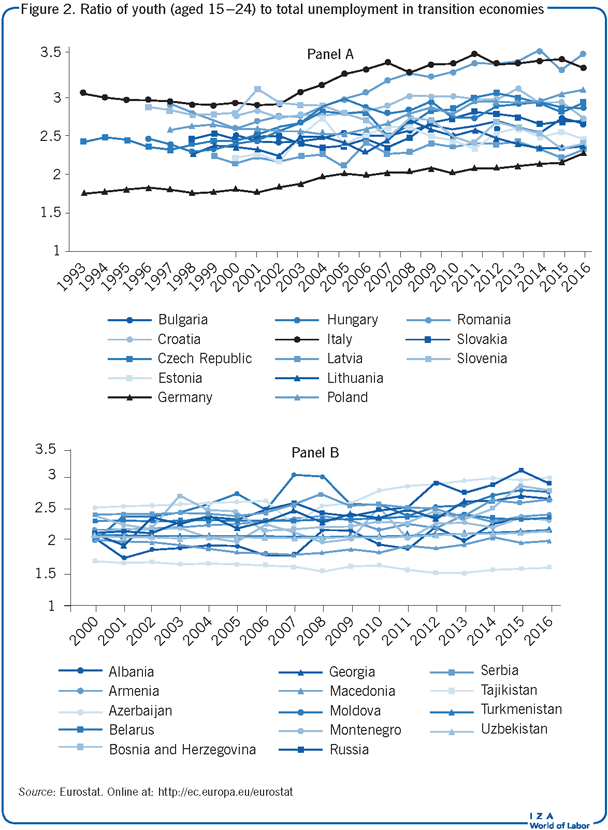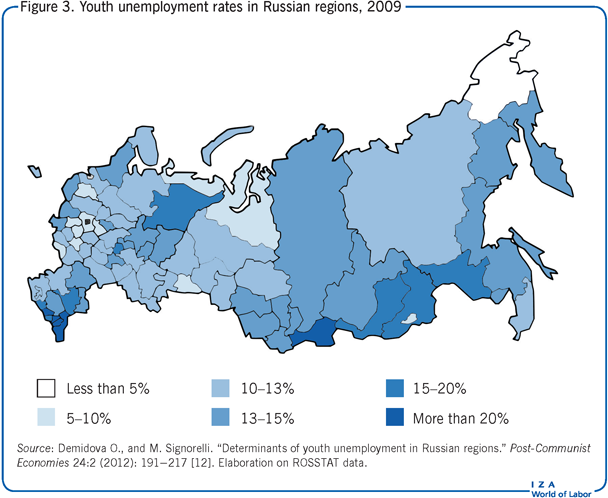Elevator pitch
The 2008 financial crisis and subsequent Great Recession created a second major employment shock in less than a generation in several transition economies. In particular, youth unemployment rates, which are usually higher than adult rates in normal times, reached extremely high levels and partly tended to persist over time. Improving youth labor market performance should therefore be a top priority for policymakers in affected transition countries. Better understanding of the dynamics of national and regional youth unemployment rates and other associated indicators is particularly important for designing effective policy approaches.

Key findings
Pros
Youth unemployment rates are two or three times the adult rates, though with marked differences across transition countries.
Recessions and crises strongly deteriorate youth employment opportunities, much more so than for adults.
In contrast to planned economies, transition and market economies have much higher and unstable unemployment rates, especially when it comes to youth unemployment.
Cons
Research on the determinants of national and regional dynamics of youth unemployment is very limited, especially for transition economies.
The unemployment rate is only one of several key indicators to cosider when measuring youth labor market performance.
Substantial variation in youth unemployment rates exists both within and across countries, making it difficult to prescribe a “one size fits all” policy response.
Author's main message
A simple one size fits all policy to improve the employment opportunities of young people in transition economies does not exist. Instead, an integrated design of broad multi-level policies tailored to each country’s unique characteristics in conjunction with specific youth-oriented ones is necessary to reduce the persisting labor-related disadvantages of young people compared to adults. While further research is certainly required, some potentially helpful policy actions to consider include the reform of educational systems to promote better school-to-work transitions and improvement of public and private employment services for young people.
Motivation
The transition period began in the early 1990s and consisted of complex systemic changes from planned to market economies, with each country following its own specific transition process (fast or gradual). Under planned economies, unemployment for all ages was very low, and all countries exhibited a more or less “extensive model of (low) growth,” with a persistently high employment rate in the context of generally stagnant productivity and GDP dynamics [1], [2], [3]. Hence, planned economic systems had several key shortcomings (e.g. low productivity growth compared to market economies) but were characterized by very low total and youth unemployment rates. Since the beginning of the 1990s the transition processes have caused net job destructions, with marked differences between countries and regions due to the more or less rapid decline in both output and employment by state-owned companies, which has only been partially compensated for by the growing private sector [1], [4], [5], [6], [7].
Thus, during the planned economy period, unemployment was not a problem at all; by contrast, unemployment, especially among youth, is the main pathology of several transition and market economies today. In the first years of transition, a massive decline in the statesector was only partially offset by privatesector growth, leading to large recessions andworsening labor market performance. Generally, this first negative “employment shock” was larger in countries that undertook a speedy transition compared to those adopting a gradual strategy. However, all transition economies eventually learned that average employment rates in market economies are generally much lower and more unstable than in planned economies. This is partly because market economies, notwithstanding the fact that they are superior to planned economies in terms of economic growth, are often hit much harder by macroeconomic shocks that, especially without appropriate counter-cyclical policies, produce temporary and persistent negative effects on unemployment, especially among youth.
Given this historical development among transition economies, the following evidence and questions have emerged: (i) Why are youth unemployment rates persistently much higher than adult ones? (ii) Why do recessions and significant crises increase youth unemployment rates much more than adult ones, with an associated high risk of incurring a “lost generation” (i.e. a generation of individuals who never enter the labor market)? (iii) Is the youth unemployment rate a sufficient indicator to evaluate the youth labor market’s performance? (iv) Why do remarkable differences in youth unemployment rates across countries and regions exist and persist? And finally, (v) what are the causes, features, and implications of persisting sub-national differences and of significant regional spatial correlation in youth unemployment rates? Even though the focus in this article is on transition economies, it should be recognized that the above questions are not exclusive to such countries and are largely shared with several mature market economies.
Discussion of pros and cons
Relevant youth unemployment national statistics
Reliable and comparable data on youth unemployment are available from Eurostat only since the mid-1990s for many transition economies. The transition economies shown in Figure 1 have been categorized into two groups: the first group comprises the (post-)transition countries of Central and Eastern Europe (PTCs, shown in panel A) that now belong to the EU and, in some cases, also to the eurozone; the second group comprises Russia and some other countries created after the Soviet Union’s disintegration, Albania, and some countries of the former Yugoslav Republic (shown in panel B). In addition, for comparative reasons, the data of two western EU countries (Germany and Italy) have been included.

With respect to the PTCs, the levels and dynamics of youth unemployment rates are significantly different in the 11 economies, ranging from below 10% to nearly 50% over the entire period. The prevailing increases until the end of the previous century were followed by a general decline until the onset of the financial crisis and the Great Recession. These shocks initiated a huge rise in youth unemployment rates, which have since declined again in recent years. The highest levels—along with high variability over time—were recorded in Croatia, especially during the last crisis, while the Czech Republic experienced the lowest levels and comparatively better stability over time. One case to highlight is Poland, especially due to its comparatively excellent performance during the past ten years (it was the only EU country without a recession). The youth unemployment rate in Poland increased slightly from 2009 to 2012, but in 2016 it declined to 17%, which is below pre-crisis levels (and far from the very high rates of the early 2000s). Cyclical variability was particularly high in some countries, especially those with greater labor market flexibility and that were more open to trade. For example, in Estonia the youth unemployment rate was close to 10% before the crisis, peaked at over 30% in 2010, and then dropped back close to 13% in recent years.
With respect to the second group of countries shown in Figure 1, panel B (non-EU transition economies), reliable and partly comparable annual data on youth unemployment rates have been available only since 2000, provided by the International Labour Organization (ILO). It should be noted that much lower and highly stable youth unemployment rates have been recorded in Russia and the other post-Soviet countries (with the partial exception of Georgia and Armenia); however, these countries are still far from completing the transition process in some respects (see the European Bank for Reconstruction and Development’s transition indicators). In contrast, the post-Yugoslav economies have experienced much higher rates and a huge range of variability (from near 30% to near 70%) and instability over time. The above differences can be explained by several factors, including the legacy of the planned period (which was different in Yugoslavia), crises and internal conflicts, progress in transition, the degree of openness to trade, differences in labor market institutions, and labor hoarding strategies.
As for the comparison with the two western EU countries, the data show very different performances: in Germany, youth unemployment rates were generally below 10%. In Italy, however, the levels were already very high before the last crisis (between 20% and 30%) and reached a maximum of 42.7% in 2014. These data thus show how significant the differences can also be between non-transition economies.
As for the ratio between youth and total unemployment rates, the data presented in Figure 2 confirm that youth unemployment rates are systematically higher than total unemployment for all examined countries. For the PTCs (panel A), youth unemployment rates are often more than double the total unemployment rates, with youth-to-total unemployment ratios ranging from 1.5 to 3.5. Moreover, the ratios have been increasing since the Great Recession. The highest values were recorded in Romania, which still had a ratio above 3.0 in 2016, and Poland, with values well over 2.0 for the entire period. The Baltic states, by contrast, show a generally lower ratio for the entire period.

For non-EU transition countries (panel B), the ratio of youth to total unemployment ranged from approximately 1.5 to 2.8, with a slight tendency to rise over time (with the exception of Tajikistan). In more recent years, most of these countries have had ratios above 2.0, with the only exceptions being Macedonia and Tajikistan.
The compared performance was again very different between Germany and Italy. In Germany, the ratio was close to 1.0 during the 1990s and recently approached 1.5. In Italy, the ratio was well over 2.0 before the crisis and has increased to above 3.0 during the last decade.
Finally, it should be stressed that for transition economies, especially those countries more integrated into the international trade system and now belonging to the EU, the 2007-2008 global financial crisis and the consequent 2008-2009 Great Recession created a second employment shock in less than a generation, with the first stemming from huge declines in GDP during the early transition period.
Youth unemployment: Key features and determinants
Based on the existing research, the following observations have been made: youth unemployment rates are generally much higher than adult rates; they are also generally more sensitive than total rates to the business cycle, in particular to recessions and significant crises. Moreover, there is substantial variation across transition countries in terms of both the levels and dynamics of youth unemployment rates; and, finally, some transition economies show huge and persisting regional differences.
The finding that youth unemployment rates are much higher than adult rates in many countries, even during normal times (i.e. non-recessionary), has prompted a growing number of empirical investigations [8]. A key factor contributing to this disparity is that young people, despite possessing, on average, higher educational levels, are endowed with fewer skills, and are less experienced than their older peers. More generally, young people encounter difficulties and obstacles when transitioning from school to the labor market. One possible explanation for this may be substantial mismatch between the knowledge acquired from formal education and the skills required by the labor market. Hence, the educational system seems to be particularly important. Studies indicate that countries with a “dual system” (i.e. with a strong integration between formal education and apprenticeships, like in Germany) can usually facilitate a better school-to-work transition and a lower youth unemployment rate than countries charcterized by “sequential systems” (i.e. a strong separation between school and work experience) [9]. The dual system seems superior to the sequential one because it enables young people to accumulate work experience while studying. Moreover, it allows private firms to detect individual abilities and invest in people through informal education, leading to an overall better match between supply and demand.
The second main empirical finding is that young people have been negatively affected, to a much greater extent, by significant economic crises, such as the early transitional recession years or the more recent Great Recession. This is also related to the greater sensitivity of youth unemployment to cyclical conditions. In fact, deep recessions drive net job destruction and lower average labor demand, which are particularly detrimental for young people. Moreover, if the recession is followed by insufficient recovery, higher permanent unemployment will result, as part of the cyclical unemployment transforms into structural unemployment.
Institutional determinants are particularly important for both youth and total unemployment. For example, empirical studies commonly show that employment protection legislation affects both worker turnover and the duration of unemployment, more so than the unemployment level; consequently, such regulations are more significant for younger than for older people. In particular, higher protections for the existing workers (primarily adult workers) could reduce the entry flows of young people into employment.
A growing body of literature has investigated the determinants of regional (sub-national) differences in youth unemployment rates [10], [11]. These differences have been shown to be particularly relevant for youth unemployment and persistent over time. Econometric investigations at the regional level (NUTS-2, i.e. the second level of the “Nomenclature of territorial units for statistics”) for 35 regions in four EU transition countries (Poland, Hungary, the Czech Republic, and Slovakia) for the pre-crisis period 1999-2006 suggest a number of regional determinants for youth unemployment rates [10]. With respect to sectoral composition effects, growing specialization in agriculture was shown to offer higher employment opportunities only for young women. In interpreting this result, it should be noted that the considered regions belong to countries with relatively advanced stages of sectoral convergence toward market economies’ standards. Hence, the primary sector (agriculture) seems able to absorb some excess female youth labor supply (referred to as a “buffer effect”); this result may also be due to differences in geographic mobility by gender, because women are sometimes less mobile. By contrast, regions with a higher industrial specialization experienced significantly reduced male youth unemployment rates. Finally, a strong presence of traditional market services (e.g. retail trade) was associated with higher rates of female youth unemployment, while a larger share of public services was detrimental for both genders.
Econometric studies about the role of institutions and policies in EU transition economies show common features for both male and female youth labor market performance. First, active labor market policies can significantly reduce youth unemployment, while passive labor market policies have the opposite effect. Second, unionization has a detrimental effect and lower regulation of the product market is associated with higher youth unemployment rates. In addition, with respect to employment protection legislation, the strictness of protection on temporary contracts increased youth unemployment rates, though only for young females. Finally, high levels of development, living in urban regions, and a greater extent of part-time employment all favor lower youth unemployment rates for both genders.
Using detailed regional data to learn more about youth unemployment
Increasingly, empirical studies have utilized regional data to focus on a single country, namely Russia. One such study investigates the determinants of youth unemployment rates in 75 Russian regions from 2000 to 2009 [12]. As shown in Figure 3, the differences in rates across regions are significant, ranging from below 5% to above 20%.

The study found that youth unemployment rates in Russia were persistently higher than adult rates, and a clear-cut spatial dependence, negative for distance (i.e. closer regions have similar rates) and positive for bordering regions (i.e. regions with a common border tend to influence each other), emerged. The first part of this finding supports results from other countries, and suggests that if potential labor market weaknesses are left unchecked (i.e. without appropriate policy interventions), the negative impacts may be felt for a long time. On the other hand, the persistence of youth unemployment may indicate that if policy efforts aimed at increasing the labor market performance of young people are successful, then the positive outcomes may also persist over time. The finding on spatial correlation indicates that supra-regional aspects (e.g. national macro policies) matter in shaping labor market performance, and that policy design should carefully consider the interactions taking place at the regional level (e.g. related to regional trade). Among the many significant explanatory variables discussed in the study, it should be especially noted that a higher level of regional economic development can lower youth unemployment (and its ratio to total unemployment); furthermore, demography, migration, and family conditions can be important factors affecting the regional youth unemployment rate and its ratio to total unemployment; and finally, regional openness to trade and a region’s export/import level can significantly affect youth unemployment (and, again, its ratio to total unemployment).
Limitations and gaps
Notwithstanding the high importance of youth labor market performance, research on the determinants of national (and regional) dynamics and differences is very limited, especially for transition economies. In particular, the investigations on the determinants of youth unemployment levels and dynamics have to be extended to other key indicators like the NEET (i.e. people who are not in employment, education, or training) index, the long-term (more than one year) youth unemployment rate, and the youth employment rate. The correlation of these indices is generally quite high, but they capture different features of young people’s complex situation in the labor market. Hence, there are ample opportunities to further study these indicators.
Finally, investigations at the regional level are particularly important for the design of an appropriate multi-level policy mix. While a growing body of literature has adopted regional data, it typically refers only to the youth unemployment rate indicator, thus also neglecting many of the important above-mentioned facets.
Summary and policy advice
Transition economies experienced two negative employment shocks in less than a generation, the “transitional recession” in the early 1990s and the Great Recession in the late 2000s; in both cases, young people were greatly affected. The data show that unemployment risk is persistently higher among the youth in transition economies, with marked differences both between and within countries. While the existing research on transition economies is insufficient to properly investigate such a complex topic, recent work regarding countries at different levels of development provides some insight for designing better policies to reduce youth unemployment in transition economies.
Considering a short-term perspective, when a recession occurs, the more convincing Keynesian approach suggests that adequate demand-side macroeconomic policies (especially increasing public investment) are essential to prevent cyclical unemployment from becoming structural, with huge effects, especially for young people. Long unemployment periods are a serious problem, since they not only erode human capital but also prevent the accumulation of work experience, generating negative effects on lifetime income and employment possibilities. Even more worryingly, they increase the risk of young people being excluded from the labor market in the long term, potentially creating a “lost generation” of people who never enter the labor market [13]. To avert this risk, especially when faced with a major economic crisis, it is necessary to combine broad counter-cyclical policies (such as increasing public investment) to reduce the intensity and duration of GDP downturns with effective specific labor and educational policies targeted at young people (such as reducing the fiscal wedge on youth labor cost).
From a long-term perspective, structural policies are needed to improve the youth labor market’s performance, including effective active and passive labor policies. These could include improvements to the job search process and providing better coverage during unemployment spells. Moreover, adequate school-to-work transition institutions and programs, as well as innovative educational, placement, and training schemes, are essential to decrease the number of young people losing effective contact with the labor market. With respect to education systems, the spread of a well-designed “dual system” seems appropriate. Moreover, innovative instruments and creative experiments should be adopted by transition countries, taking into account the specific level of transition and the key structural and institutional features present in each country. These measures could halt the continued growth of intergenerational inequality and reduce the wide differences in age-specific unemployment rates.
Empirical investigations at the regional level further highlight the various potential factors affecting youth unemployment rates, with important implications for the design of effective multi-level policy interventions. In short, wide regional differences suggest a role for specific sub-national policies, while the clear evidence of a positive spatial correlation supports the key role of national level policies.
Reducing the huge youth unemployment rates should be a top priority for both national and regional policymakers. However, to determine the makeup of a proper policy mix, researchers must produce more and better studies regarding this complex topic, particularly as it relates to transition economies. Despite the need for further research, it is already clear that a one size fits all policy against youth unemployment does not exist; rather, policymakers must carefully consider the determinants of youth unemployment along with several related indicators to combat the issue using a mix of structural, institutional, cyclical, and labor policies.
Acknowledgments
The author thanks an anonymous referee and the IZA World of Labor editors for many helpful suggestions on earlier drafts. Previous work of the author contains a large number of background references for the material presented here and has been used intensively in all major parts of this article [8], [10], [11].
Competing interests
The IZA World of Labor project is committed to the IZA Guiding Principles of Research Integrity. The author declares to have observed these principles.
© Marcello Signorelli